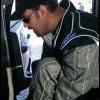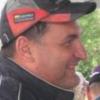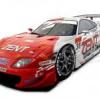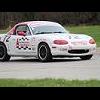Understanding the hubs that don't fail I believe is the key here.
Hub bearing failures are an issue, hub flange failures I have never personally seen with the Miata. The rx7 failures in EP were the steel hats failing, and the replacement kit used the original bearing setup.
Random thoughts on the subject:
Tapered bearings are better for what we do, they have a line to transmit forces instead of a "point" that the ball bearing style has. You have keep up with and set preload tho, and that is done dimensionally with the ball bearing style, therefore a wide torque range.
The flange failure pictures I have seen here I believe are absolutely from installing studs wrong. Studs should have MAX .005 interfenence. Own the right ream for the brand of stud you are using. If you have to use a press to put in studs, that is too tight. You should be able to hold the hub in your hand and drive the stud in with a hammer, and hear the tone change when it seats. Drive the stock studs out the same way, and see how tight they are. 2 hits or maybe 3.
We all need to realize the parts supply chain when talking about this. There is no consistency. We are racing mass produced parts for an econobox. Price point is not a relation to quality. Steel supply price variance, shipping industry price flux, and quarterly growth or not have more bearing (ha) on the bearing quality IMO.
I have had expensive hubs fail almost immediately. We tried expensive hubs for the 25hour 2 years ago, and went thru 4 of them. The last month or so I have done 6 hubs on 2 cars, including 3 rears. All have the best grease made. Texas 8 hr enduro is a rough place.
I have opened boxes on an order of a dozen hubs, and got the same hub out of two different brands with 100% price variance. I have gotten hubs from the same brand and had one made in china and one made in japan. I now seek out a "look" of the induction hardening of the outer races that seems to correlate with long life. Hardly scientific I know.
Last year I went back to cheap hubs for the 25, and we won the race in E2, no issues. Hubs were on the car, no issues thru last weeks majors (it ran TWS 8 hour), until a renter spun the car over curbs and pot holes. 2 sessions later they were audible.
If your car is pushy, then everything on the track you encounter is harder on the hubs.
The lower you run your car, the more shock the hubs get IMO and the faster they fail.
I torque front hubs to 165. Rear hubs are trickier. Replace the drive flange more often then you think, and torque the cv correct. Rear hubs do take a good feel with the press, and the press fit of the inner drive flange is critical.
Hubs that get "fast loose" (A tick of play) and stay that way, often last the season.
Re-torquing the nuts are an indicator you are losing one. If the nut moves, it is a matter of a few sessions.
If you want to set up a loose bearing, do it with shims between races, not loose torque. But, this is a red herring IMO.
Having said all that I do think a solution to the problem would be very doable. Talking about 25K research and patents is not helpful. We have a single dimension spindle that with a little research, probably already has a mass produced hub with a larger bearing off some heavier car like a nissan or toyota or kia. Worst case I imagine is making a spindle collar to a slightly larger bearing ID.
But, everyone, allowing a hat and rotor combo to get back to the stock mounted caliper will be a neccessity here I would imagine.
Since STL rules have the lattitude to do this, that is my plan if and when I ever get enough time to make progress on that car.
Well thats my alloted forum time for awhile.
My .02
Kyle




 Sign In
Sign In Create Account
Create Account







 Back to top
Back to top Report
Report




















